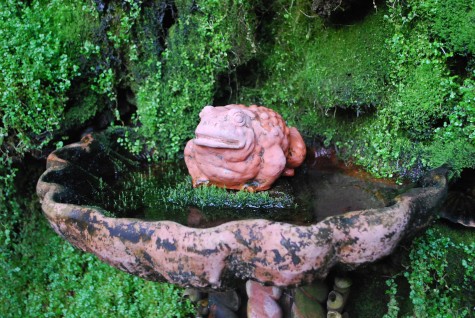 What’s new-we are on the verge of a change of seasons. Is that new? No, not really. The change of the seasons, the full moon, the length of the days, the natural changing of the guard – not new, cyclical. My crocus are poking out of the ground right now like they do every year at this time. It is their time to emerge, no matter the weather. It could be a good year, or a wash for the crocus. Right now, I am watching a blizzard bury those buds out the window; I hope they survive the insult. The forecast for tonight-a shudderingly chilly 11 degrees. However there’s plenty going on inside that is new. Though I have had this Italian terra cotta frog for 15 years, he looks new, having had a much needed soak and scrub down.
What’s new-we are on the verge of a change of seasons. Is that new? No, not really. The change of the seasons, the full moon, the length of the days, the natural changing of the guard – not new, cyclical. My crocus are poking out of the ground right now like they do every year at this time. It is their time to emerge, no matter the weather. It could be a good year, or a wash for the crocus. Right now, I am watching a blizzard bury those buds out the window; I hope they survive the insult. The forecast for tonight-a shudderingly chilly 11 degrees. However there’s plenty going on inside that is new. Though I have had this Italian terra cotta frog for 15 years, he looks new, having had a much needed soak and scrub down.
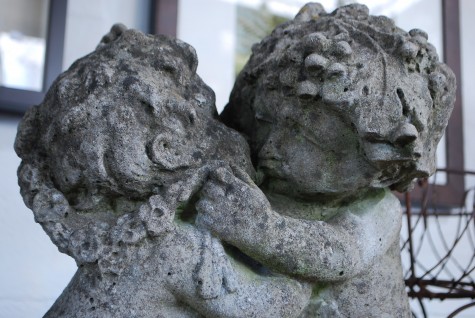 Though I can appreciate abstract sculpture in the landscape, figures and faces appeal to me more. Putti, cherubs and angels have a long history of representation in the garden. Though I have always thought cherubs and angels had a religious connotation, the putti are usually mischievious and romantic figures. This antique limestone sculpture of putti is charmingly typical. The embrace is all the more charming for a garland of flowers.
Though I can appreciate abstract sculpture in the landscape, figures and faces appeal to me more. Putti, cherubs and angels have a long history of representation in the garden. Though I have always thought cherubs and angels had a religious connotation, the putti are usually mischievious and romantic figures. This antique limestone sculpture of putti is charmingly typical. The embrace is all the more charming for a garland of flowers. 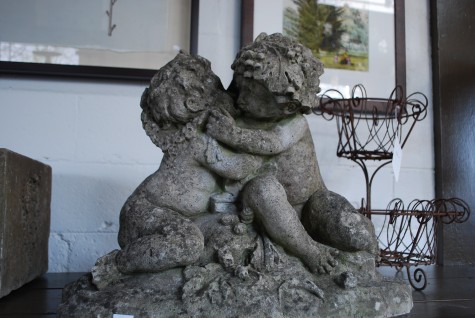 Putti were a very popular subject matter in Italian art, especially during the Renaissance and Baroque periods. Garden sculpture in the Italian style can be found in many western European countries. My collection of terra cotta pots-classical Italian in style and make. This sculpture greatly predates the cast limestone works of contemporary ornament makers, such as Haddenstone, or Chilstone, who produce their version of these kissing putti.
Putti were a very popular subject matter in Italian art, especially during the Renaissance and Baroque periods. Garden sculpture in the Italian style can be found in many western European countries. My collection of terra cotta pots-classical Italian in style and make. This sculpture greatly predates the cast limestone works of contemporary ornament makers, such as Haddenstone, or Chilstone, who produce their version of these kissing putti.
 Should kissing putti not be your idea of a great subject for a garden sculpture, we have the companion piece. These putti appear to be having a serious disagreement about something. With representational sculpture, there is a story being told-a narrative. The one is so enraged with the other, he is tugging at his own face. One cannot help but smile at the level of frustration depicted here. Both of these sculptures have been reproduced many times by different companies. The age of these sculptures imparts a patina to the surface which is as important as the subject matter.
Should kissing putti not be your idea of a great subject for a garden sculpture, we have the companion piece. These putti appear to be having a serious disagreement about something. With representational sculpture, there is a story being told-a narrative. The one is so enraged with the other, he is tugging at his own face. One cannot help but smile at the level of frustration depicted here. Both of these sculptures have been reproduced many times by different companies. The age of these sculptures imparts a patina to the surface which is as important as the subject matter.
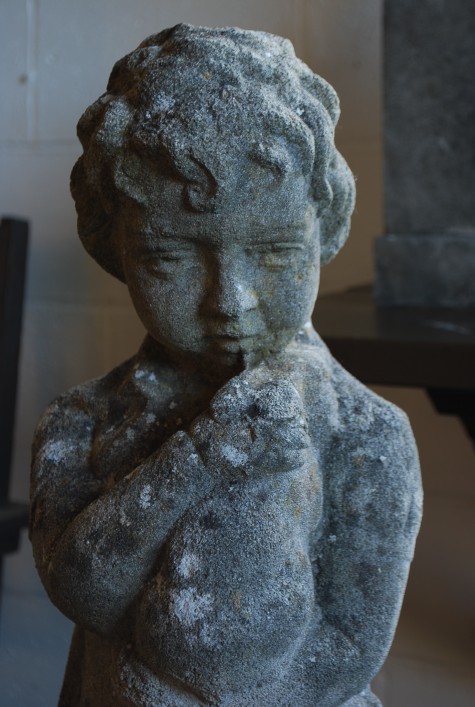 The face on this antique English garden sculpture is quietly and typically English in character. The young boy is holding a rabbit. Not seen in this picture-he is wearing nothing but a cape! I am sure there is a story here; the English garden antiques dealer from whom he came called him “Rabbit Boy”; no other information was forthcoming. His expression is serene; he will be easy to place in a special spot in a garden.
The face on this antique English garden sculpture is quietly and typically English in character. The young boy is holding a rabbit. Not seen in this picture-he is wearing nothing but a cape! I am sure there is a story here; the English garden antiques dealer from whom he came called him “Rabbit Boy”; no other information was forthcoming. His expression is serene; he will be easy to place in a special spot in a garden.
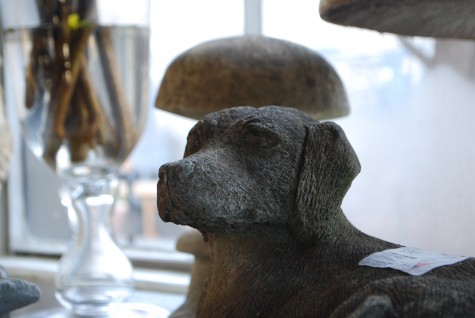 This carved concrete dog is old enough to have acquired a great patina. The dog has that stoic serious look that I love so much about my corgi Howard. There are those dogs that have jobs, and take their job to heart like this retriever-and then there are clown dogs like my Milo.
This carved concrete dog is old enough to have acquired a great patina. The dog has that stoic serious look that I love so much about my corgi Howard. There are those dogs that have jobs, and take their job to heart like this retriever-and then there are clown dogs like my Milo.
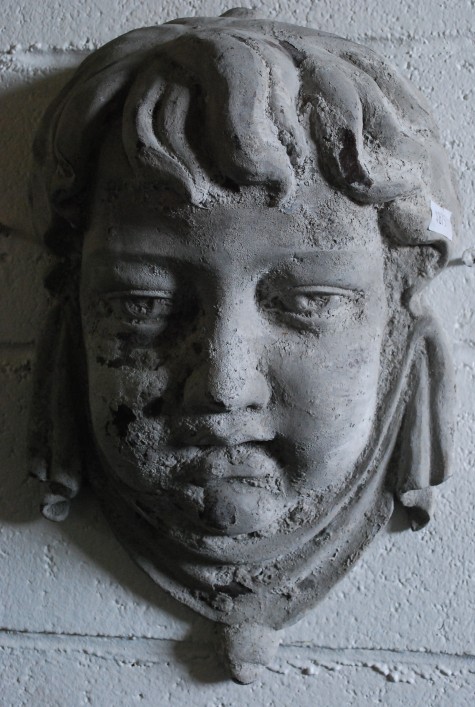 More than likely, this is an antique architectural casting that might have been a medallion on a wall or pillar. I am guessing here. The origin of this cherubic face-I have no idea. Lots of garden and architectural ornament was produced with no stamp or identifying marks. We can often date an iron piece based on the level of corrosion, the composition or appearance of the paint, or lichens growing on the surface. Some blackened limestone pieces can be dated to the Industrial Revolution. But often the story needs to come from the imagination.
More than likely, this is an antique architectural casting that might have been a medallion on a wall or pillar. I am guessing here. The origin of this cherubic face-I have no idea. Lots of garden and architectural ornament was produced with no stamp or identifying marks. We can often date an iron piece based on the level of corrosion, the composition or appearance of the paint, or lichens growing on the surface. Some blackened limestone pieces can be dated to the Industrial Revolution. But often the story needs to come from the imagination.
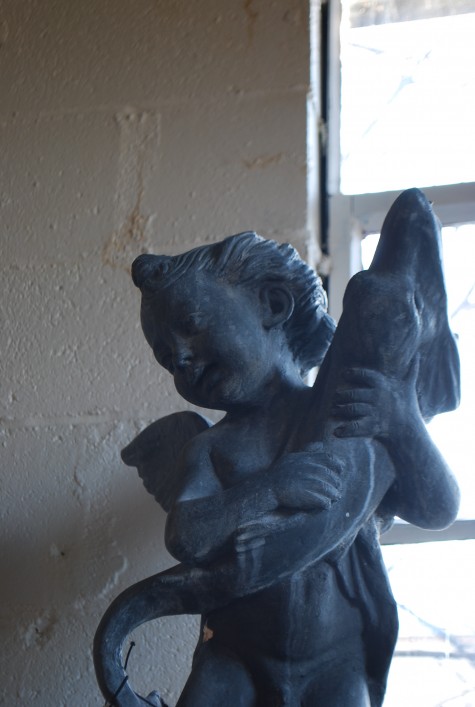 This vertical spouting lead fountain of a boy holding a fish is easier to trace. Made by H. Crowther Ltd. in London, it is after the original by Verrochio, sculpted between 1435 and 1488. The orginal is still on display at the Palazzo Vecchio in Florence, Italy. It is another example of a figurative representation so popular with gardeners it is still made to the present day.
This vertical spouting lead fountain of a boy holding a fish is easier to trace. Made by H. Crowther Ltd. in London, it is after the original by Verrochio, sculpted between 1435 and 1488. The orginal is still on display at the Palazzo Vecchio in Florence, Italy. It is another example of a figurative representation so popular with gardeners it is still made to the present day.
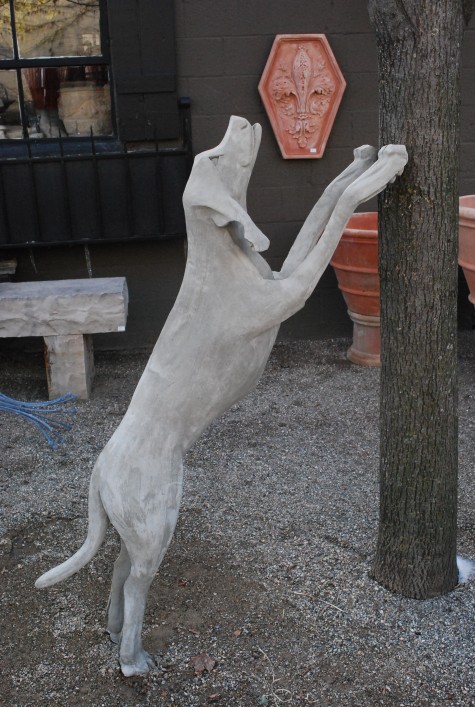 A local sculptor is in the process of hand carving his third pack of hounds for me. A steel and concrete core is finished with a hand carved mortar layer. This hound barking up a tree is a perfect garden ornament, as it clearly interacts with the landscape. The sculpture is very contemporary and pared down interpretation of the spirit of a hound.
A local sculptor is in the process of hand carving his third pack of hounds for me. A steel and concrete core is finished with a hand carved mortar layer. This hound barking up a tree is a perfect garden ornament, as it clearly interacts with the landscape. The sculpture is very contemporary and pared down interpretation of the spirit of a hound.
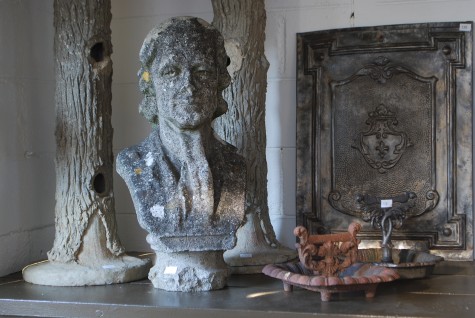
A bust is a sculpture representing the head, shoulders and upper chest of a person. This particular carved stone bust is English. Who is portrayed here, I have no idea. A bust can be a powerful focal point in a garden, especially if set at eye level. Making eye contact is one of those complicated things that living creatures do. Any of these sculptures new to the shop, I would place in the garden at eye level, so the conversation could begin.